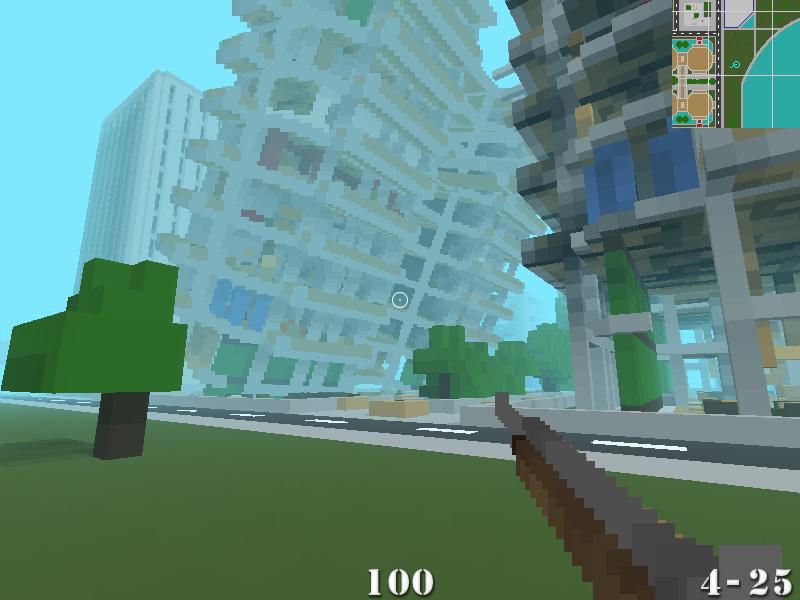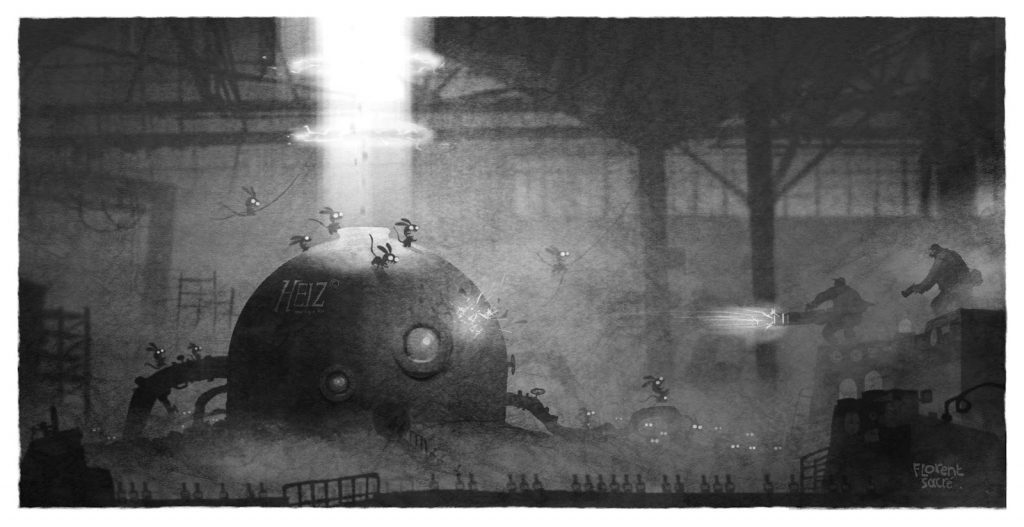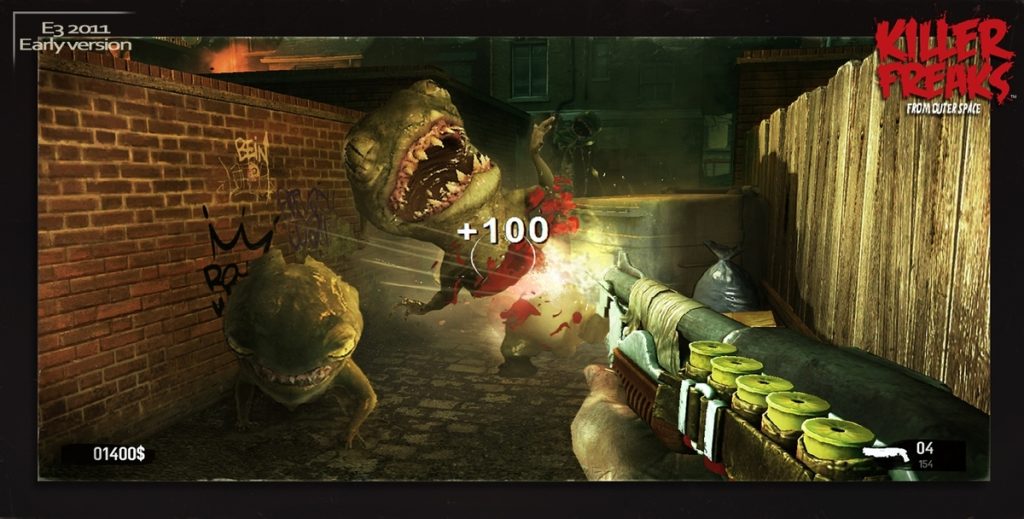Prax War 2018 was an ambitious FPS that was in development in late ‘90s by Rebel Boat Rocker and would have been published by Electronic Arts, but it was cancelled in january 1999 when the publisher pulled the plug on the project because “things were not progressing as quickly as they would have liked”. The project was quite hyped at the time, because Rebel Boat Rocker was composed of former 3D Realms developers (such as Billy Zelsnack, Jason Zelsnack, Lee Kime, James Storey, Dirk A. Jones, Brian Martel, James Storey and Randy Pitchford), a team that previously created such classic FPS as Duke Nukem 3D, Shadow Warrior and Blood.
The game was being developed using a Java 3D engine, to permit a different number of polygons shown depending on the distance of the player from the enemies and enviroment:
“As players pull back from an adversary, the polygon count will go from a high of 1,000 up close to 150 at a distance. This will allow RBR to “bring back the mow-down,” according to Pitchford, where you’ll face a platoon of up to 50 soldiers at a time.”
Gameplay would have been somehow similar to Half Life, with players being sent to the field to take out a terrorist menace:
“The story for Prax War was this. In 2032 the megalomaniac known as Dante takes over Prax Industries using Nikki Praxus, recent inheritor of the company, as a pawn. He is now using the power source Praxium to create an army of mutants and you, along with your military squad known as the Eclipse Team, must stop him from causing global havoc.”
The story would have unfold through a quite open-ended series of areas to explore, with players being able to interact with the environment and vehicles, for example by stealing a mech from enemies to gain more firepower. Online multiplayer with classic modes such as Capture the Flag and Rocket Arena was planned too.
Prax War’s cancellation became quite infamous because it was announced through Randy Pitchford’s .plan file (a system used at the time to log a developer’s task list, notes and future plans):
“The word from EA that’s out there about why Prax War was cancelled just about sums it up. “EA’s reasons were that they missed their technology window on this product and that things were not progressing as quickly as they would have liked.”
I need to mention, however, that the RBR content team was working closely with the on-site EA director of development on tight content schedules and milestones right up to the end. This includes all game art, models, levels, animation, artist objects, sound effects, etc.
[…] I am truly sorry that the gaming public will never get to play Prax War, for it was truly becoming something remarkable.
It was with sad but optimistic fever I cleaned my office yesterday, I am proud of my work on Prax War and am rewarded by the respect it had received from those who had the almost unique pleasure of being exposed to what we were creating. It should’ve been revolutionary for single-player gaming.
But, alas, “our game is but a dream“.”
The last sentence from Randy’s .plan file is a reference to something wrote a few weeks before by Apogee / 3D Realm’s Scott Miller, still angry with Rebel Boat Rocker because they left 3D Realms. After the early rumors of Prax War’s cancellation, Miller celebrated / joked about it saying “Row, row, your boat, Our game is but a dream”.
Some more details about Prax War 2018 were shared by Pitchford in an article on Loonygames:
“Some interesting things were happening in the industry that influenced us two years ago when we were designing the game. The third person 3D game was evolving and it was exciting a lot of people. We had played Tomb Raider and Mario 64 and were taken by some aspects of what those games provided. I concluded that it wasn’t the third person perspective in itself that was so great. After all, we (like everyone else) had difficulty adjusting to the problems of the control interface for both Tomb Raider and Mario 64. It seemed to be consistent that every third person game was much more difficult to control than the first person games we were used to. However, the thing that was uniquely cool about the third person game was that you could witness your character up-close performing cool moves and displaying animations and behavior that were fun to watch. That perspective was impossible, by definition, in a first person game. Our solution was to add several characters that were partners with the player that could exist in the game with the player and give us all the cool advantages of a third person game without the disadvantages of an indirect interface. It just looked cool to see a guy back flip off a wall or something. Since you’d never see your own character perform the act (as your eyes are in his head), we used the other friendly characters to show off the cool animations. The key to this would be hundreds of custom scripted animations and some good friendly partner AI.”
“Prax War was becoming a first person shooter with a squad, but I wouldn’t call it a squad based game. “Squad based game” implies that the player must give commands to the other members of the squad. In Prax War, the friendly characters would act on their own. Our player wasn’t required to command the other teammates any more than Luke commanded Han Solo in the movie.”
“In addition to developing an amazing 3D rendering engine, the Zelsnacks were big fans of physics. The content developers had just come off working on Shadow Warrior, which was one of the first 3D shooters to feature vehicles that the player could jump in and out of. The game didn’t do vehicles realistically because of the limits of the sector based engine, but it was still fun. And, we were seeing how vehicle combat gaming with more realistic physics could make a really fun deathmatch in I-76. Our engineers were sure they could outdo the physics in I-76 (which they did) so vehicles became a big part of Prax War.”
“Finally, most of us knew that the future of the 3D shooter was going to finally have to take the player outdoors. Attempts at outdoor areas within engines designed for corridor shooters up that point had been not believable, at best. But, fortunately, the engine that was being constructed at RBR was based around the concept of arbitrary polygons. This would allow us to have small and detailed geometry for complex indoor environments and have huge polygons that could build a vast terrain mesh. We were going to be the first 3D shooter that did outdoor environments in the quality of a racing game or military sim.”
“[…] another game appeared that made extensive use of scripted animations and presented friendly characters. Half-Life turned out to be a huge success which begged questions from our publisher about whether or not we could compete. Considering that at the time of Half-Life’s release, we had tons of quality content and some great rendering features, but no actual game, I must assume that some worried that we could not.”
After Prax War 2018 was cancelled, Rebel Boat Rocker was closed down but a few members lead by Randy Pitchford went on to fund Gearbox Software and created popular Half Life expansion packs Opposing Force and Blue Shift. In Half Life: Blue Shift, there’s an easter egg about Prax War: “In the laundromat, a scientist and a security guard are playing a fighting arcade video game, named Prax Wars 2: Dante’s Revenge; the security guard eventually loses the game.”
Images:


![Chroma (by Harmonix) [PC – Alpha / Cancelled] Chroma (by Harmonix) [PC – Alpha / Cancelled]](https://www.unseen64.net/wp-content/uploads/2016/11/chroma-harmonix-music-fps-cancelled-alpha-01-670x300.jpg)

